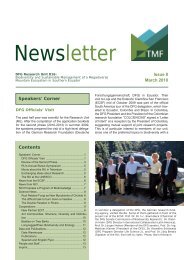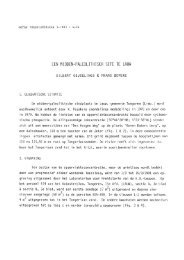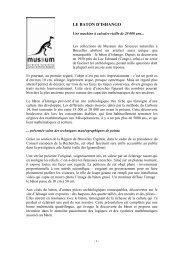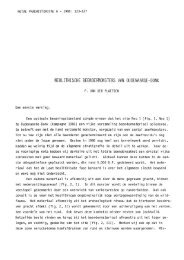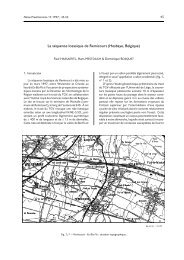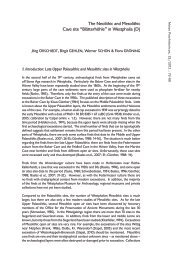Terebratula Daleidensis - Royal Belgian Institute of Natural Sciences
Terebratula Daleidensis - Royal Belgian Institute of Natural Sciences
Terebratula Daleidensis - Royal Belgian Institute of Natural Sciences
You also want an ePaper? Increase the reach of your titles
YUMPU automatically turns print PDFs into web optimized ePapers that Google loves.
52 Paul SARTENAER<br />
WeRneR (1980, fig. 16, p. 17), is completely different<br />
from the holotype figured by her in 1941 (pl. 1, figs<br />
2a,b).<br />
The Upper Emsian species Rhynchonella imitatrix<br />
FuchS in SpRieSteRSbach & FuchS, 1909 from the<br />
Bergisches Land and R. (Wilsonia) dillensis FuchS,<br />
1914 from the Dill Syncline are not identical to<br />
hexatoma wetteldorfensis, a possibility set forth by<br />
Schmidt (1941, p. 9); according to her, R. imitatrix<br />
could be a juvenile <strong>of</strong> hexatoma wetteldorfensis. These<br />
two remarks indicate that Schmidt’s conception <strong>of</strong> the<br />
subspecies was unclear.<br />
According to the author, the subspecies hexatoma<br />
soetenica, that covers most <strong>of</strong> this range, contains<br />
more than one taxon, a possibility already envisaged by<br />
Schmidt (p. 11) for the specimens from the Sötenich<br />
Syncline. Furthermore, although the subspecies is<br />
present in two synclines, all figured and sectioned<br />
specimens come from the Givetian <strong>of</strong> a restricted area<br />
(Sötenich and surroundings) in the Sötenich Syncline:<br />
holotype (pl. 1, figs 4a-c) and one paratype (pl. 1,<br />
figs 5a, b) from the “Stringocephalen-Kalk” and two<br />
paratypes (pl. 4, figs 57a, b; pl. 5, figs 5-8) from the<br />
“Stringocephalen-Schichten”.<br />
As concerns hexatoma hexatoma, SaRtenaeR<br />
(2007, p. 45) reminded that the “Geeser Horizont” near<br />
Üxheim in the Hillesheim Syncline is <strong>of</strong> early Eifelian<br />
age (lower “Nohner Schichten”), and therefore not<br />
equivalent, contrary to Schmidt’s statement, to the<br />
“Geeser Horizont” <strong>of</strong> the Gerolstein Syncline, which<br />
is located in the upper part <strong>of</strong> the Ahrdorf Formation<br />
(middle Eifelian).<br />
After examination <strong>of</strong> the original collections<br />
the author concludes that the external characters <strong>of</strong><br />
the subspecies hexatoma soetenica and hexatoma<br />
wetteldorfensis differ considerably from those <strong>of</strong><br />
hexatoma hexatoma, although some internal features<br />
show some analogy. They belong to two different<br />
genera, none <strong>of</strong> them being Oligoptycherhynchus<br />
SaRtenaeR, 1970, the genus to which hexatomus and<br />
daleidensis belong. Is Cupularostrum SaRtenaeR,<br />
1961 the genus to which Camarotoechia hexatoma<br />
soetenica should be assigned? LaRdeux & MoRzadec<br />
(1979, p. 23 as “Camarotoechia” soetenica) elevated<br />
the subspecies to the rank <strong>of</strong> a species that BRice<br />
(in BRice & MoRzadec, 1983, pp. 549-550, 553-<br />
555, pl.1, figs 1a, b, 2-7) described and attributed to<br />
Cupularostrum. This is an acceptable proposition<br />
for the Lower Givetian (Tibidy Formation) 40 (~)<br />
specimens from two sections near Le Faou (“Rade<br />
de Brest”, “Département du Finistère”, Armorican<br />
Massif), but it does not apply to the original Eifelian<br />
material, which is difficult to tackle. The holotype<br />
(XVII 323c) is stratigraphically (“Stringocephalen-<br />
Kalk”) and geographically (Sötenich) unsatisfactorily<br />
located. The largest collection <strong>of</strong> hexatoma soetenica<br />
comes from the middle Eifelian Ahrdorf and Junkerberg<br />
Formations in the central part <strong>of</strong> the Sötenich Syncline;<br />
it is particularly abundant in the Dalbenden horizon<br />
(third from base <strong>of</strong> the four recognized in the Junkerberg<br />
Formation) (PauluS, 1961a, pp. 424, 427-429, 432;<br />
1961b, pp. 32, 38; Dickfeld, 1968, unpublished thesis:<br />
“Stratigraphie und Fauna im Westteil der Sötenicher<br />
Mulde”). Dalbenden is only two kilometres to the east<br />
<strong>of</strong> Sötenich. It is surprising that Schmidt (1941, p.<br />
11) mentioned as coming from the “Stringocephalen-<br />
Schichten” an old and large collection she examined in<br />
the “Landesmuseum” (Berlin), because the path Urft-<br />
Gïrzenberg from where this collection derives is also<br />
in Dalbenden or close to it. It is also remarkable that<br />
similar material coming from the same formation has<br />
been collected from the near-by Blankenheim (OchS<br />
& WolfaRt, 1961, pp. 23, 28, 30) and Rohr (GlinSki,<br />
1961, pp. 279, 281, 283) Synclines. In short, a thorough<br />
examination is needed for clarifying the stratigraphic<br />
position and range <strong>of</strong> the subspecies in its type area,<br />
and for dealing with the various taxa that have been<br />
identified as such in France (“Rade de Brest”; Lower<br />
Givetian), Germany (Sauerland; Middle Eifelian),<br />
in Libya (Fezzan; Couvinian and Givetian-Frasnian<br />
transition beds), in Mauritania [Adrar; Givetian-<br />
Frasnian boundary beds (probably Frasnian)], and<br />
in Spain (Cantabrian Cordillera; Efelian-Givetian<br />
transition beds).<br />
Le MaîtRe (1952a, p. 112) stated that C. daleidensis<br />
presented “variations”. The same year (1952b, p. 328)<br />
she called “groupe de C. daleidensis” “toute une série<br />
d’espèces” gathered around the species in the whole<br />
Devonian <strong>of</strong> Europe and North America. According<br />
to her, in Europe the Lower Devonian section (C.<br />
daleidensis and C. nympha) <strong>of</strong> this group was replaced<br />
in the Middle and Upper Devonian by “toute une série<br />
de formes voisines” showing “variations” in various<br />
characters: C. elliptica, C. hexatoma, C. hexatoma<br />
soetenica, C. hexatoma wetteldorfensis, C. triloba<br />
fornicata, C. ferquensis, C. letiensis, C. omaliusi, C.<br />
triaequalis. Le MaîtRe admitted presence <strong>of</strong> similar<br />
species (“espèces similaires”) in the United States<br />
<strong>of</strong> America in the Lower Devonian (C. oriskania),<br />
and the Middle and Upper Devonian (C. congregata,<br />
C. congregata var. parkheadensis, C. horsfordi,<br />
C. orbicularis, and C. prolifica). She (Le MaîtRe,<br />
1952b, p. 329) also recognised in Mauritania (Adrar)<br />
three “types principaux” or “groupes”, one <strong>of</strong> them



